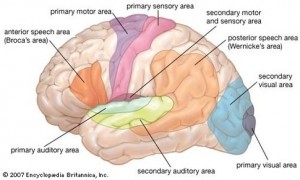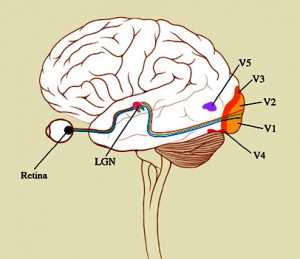Are optical illusions an obscure phenomenon that cause our visual processing to go haywire? Absolutely not! Optical illusions are in fact images that play on the very complex pathways of our vision to cause us to perceive an image in an abnormal way. Visual processing encompasses many pathways in our brain and requires the activity of many different areas. To unravel the myths of optical illusions we will show you two examples of optical illusions and explain the processes causing you to perceive an unusual image.
Illusion 1: Vases or Men?
Which image jumps out at you first, the white vases or the black human figures in the background? There is no right or wrong answer! This optical illusion is one of many created playing on the Gestalt grouping principles. These principles help to explain why your brain sees certain things: by grouping certain aspects of an image together and others apart. This optical illusion focuses on the principle of Figure & Background grouping. In this method of grouping, your brain determines what is the main figure and what is the background of an image, causing you to separate the two aspects. Eventually, you end up focusing on one more than the other. For example, let’s say you first see the white vases rather than the human figures. Your brain initially grouped the image into a figure of vases and a black background causing you to see the vases and ignore the human figures. However, you may have also separated the image by observing the black human figures as the main figure and the white as the background resulting in the opposite effect.

An image of the primary visual cortex or the V1 region of the brain. The V1 region is seen in dark blue to the right of the image.
There are many parts of your brain that are used in order to do this grouping, but the main area is most likely the primary visual cortex or the V1 region. This region is responsible for detecting edges and boundaries of an image. Therefore, it is active when deciphering between the figure and background of an image. However, it is very important to keep in mind that the V1 region is not the only area active when perceiving this image, or any image for that matter. Areas that perceive color, shade, object recognition, etc. are also active when looking at such an image.
Illusion 2: Enigma Illusion
Do not let this image trick you! This is a still image even though you might get a headache from staring at it for too long, as it appears to be moving or shaking. Many parts of your visual system are being activated while looking at this image. To start, your V4 area is processing the colors of the image, which is not specific to an optical illusion. What causes this image to look as if it is moving involves the activation of your V5/MT area of the brain. This area is responsible for detecting real movement. However, it has also been found to be activated when looking an an optical illusion like this one (Ward, 2015). Therefore, you are activating the same area that causes you to perceive motion when it is not present.

An image showing the V4 and V5 areas of the brain.
The illusion of movement, such as in the above picture, may be caused by tiny adjustments and fluctuations in your eye fixation. Your eye is rapidly trying to process all of the aspects of the complicated image causing you to perceive the image as if it were moving (Troncoso et. al, 2008). These tiny fluctuations are still not fully understood but may account for such an illusion.
So what?
An optical illusion is an image that uses your normal visual pathways to trick your mind into thinking you see one thing over another. Your brain processes visual images in a highly complex and organized way. There are many parts, and only a few were explained in this post. A lone process is never activated without the activation of many others. Hopefully the mystery of optical illusions is a little less mysterious for you now!
References:
Ward, Jamie. The Student’s Guide to Cognitive Neuroscience. Hove, East Sussex: Psychology, 2015.
https://www.quora.com/How-much-of-the-brain-is-involved-with-vision
http://www.huffingtonpost.com/2013/05/30/10-optical-illusions_n_3354122.html
http://vanseodesign.com/web-design/gestalt-principles-of-perception/
http://journal.frontiersin.org/article/10.3389/fnhum.2013.00730/full


